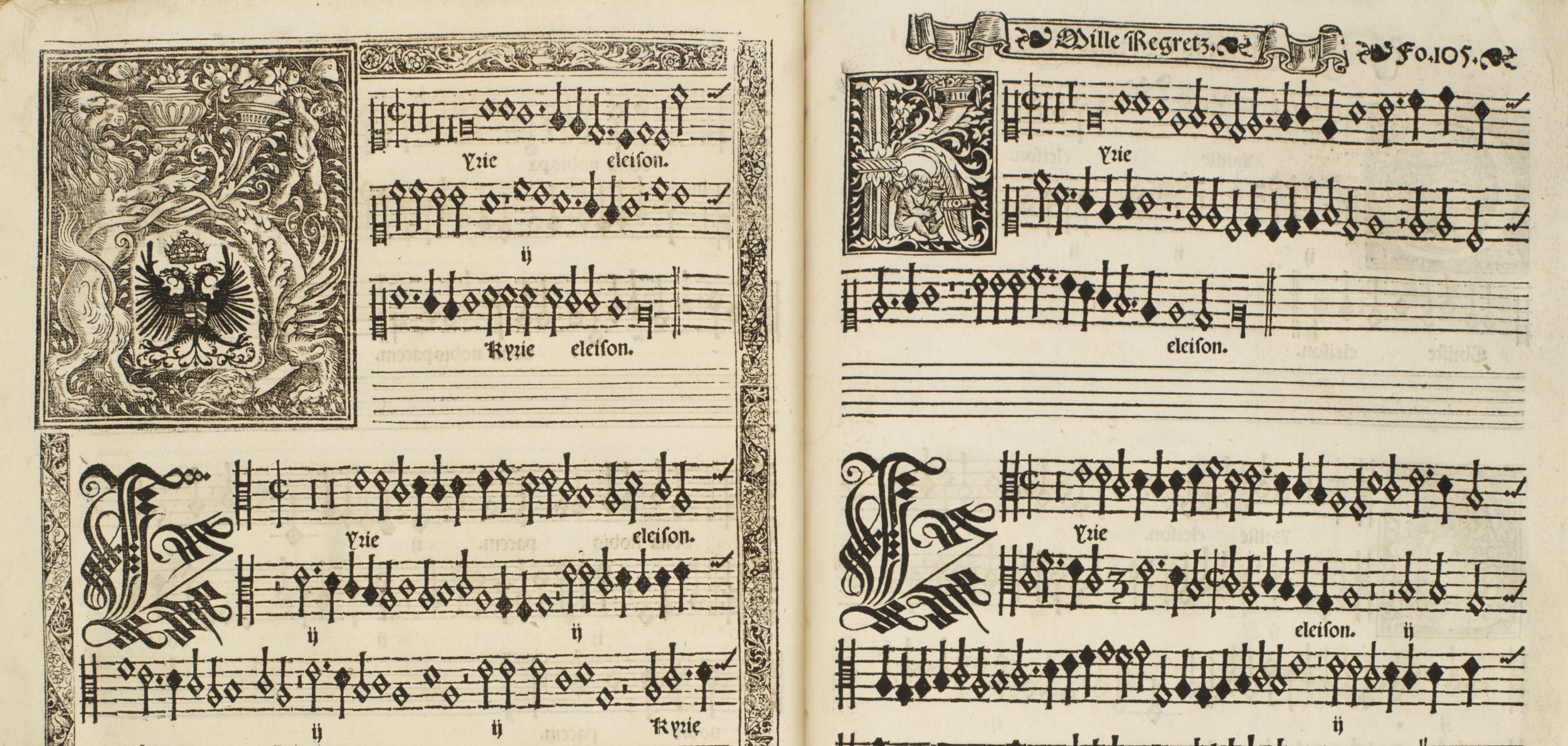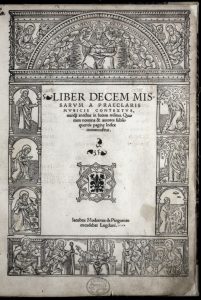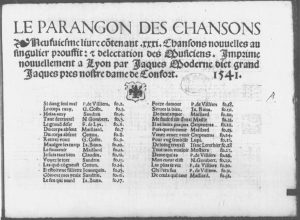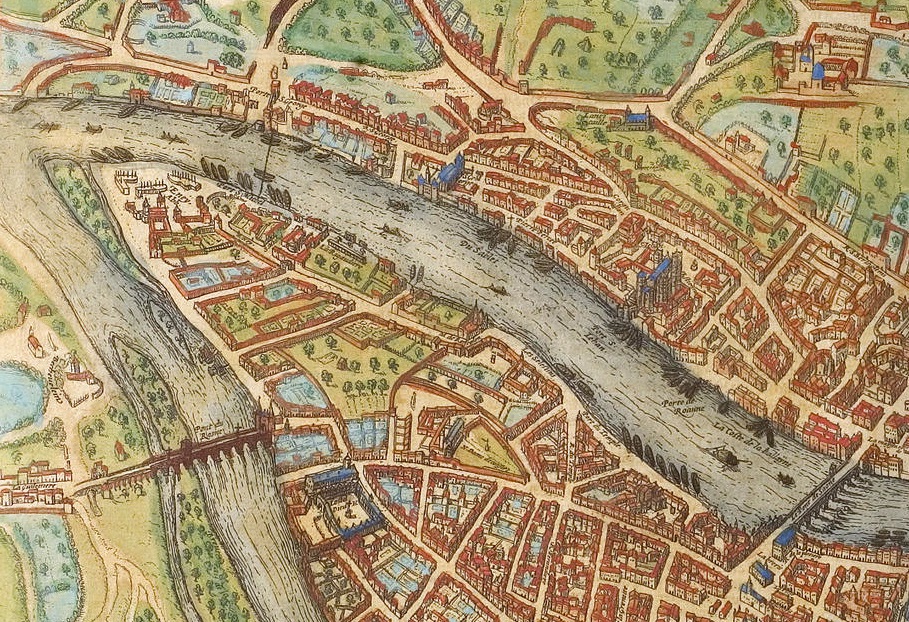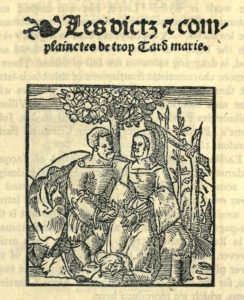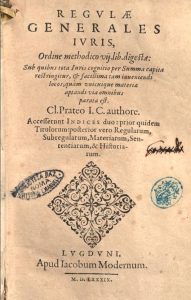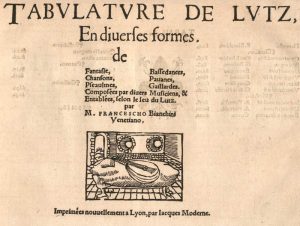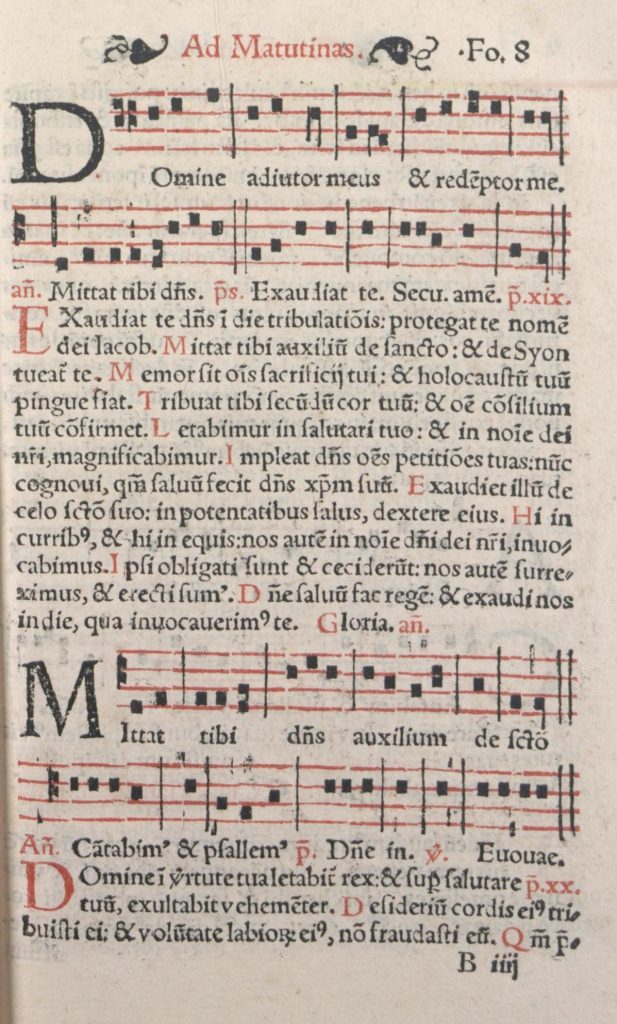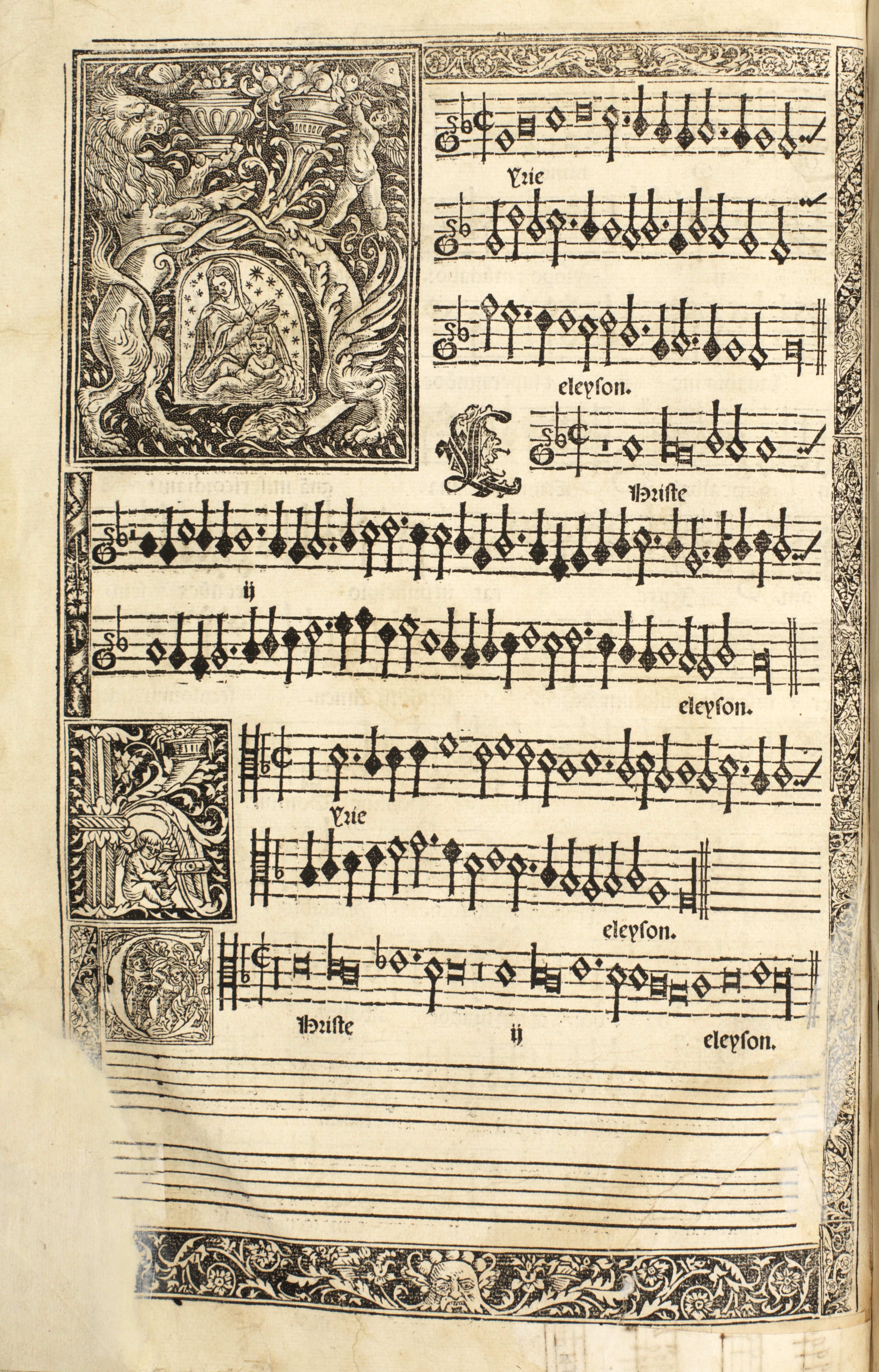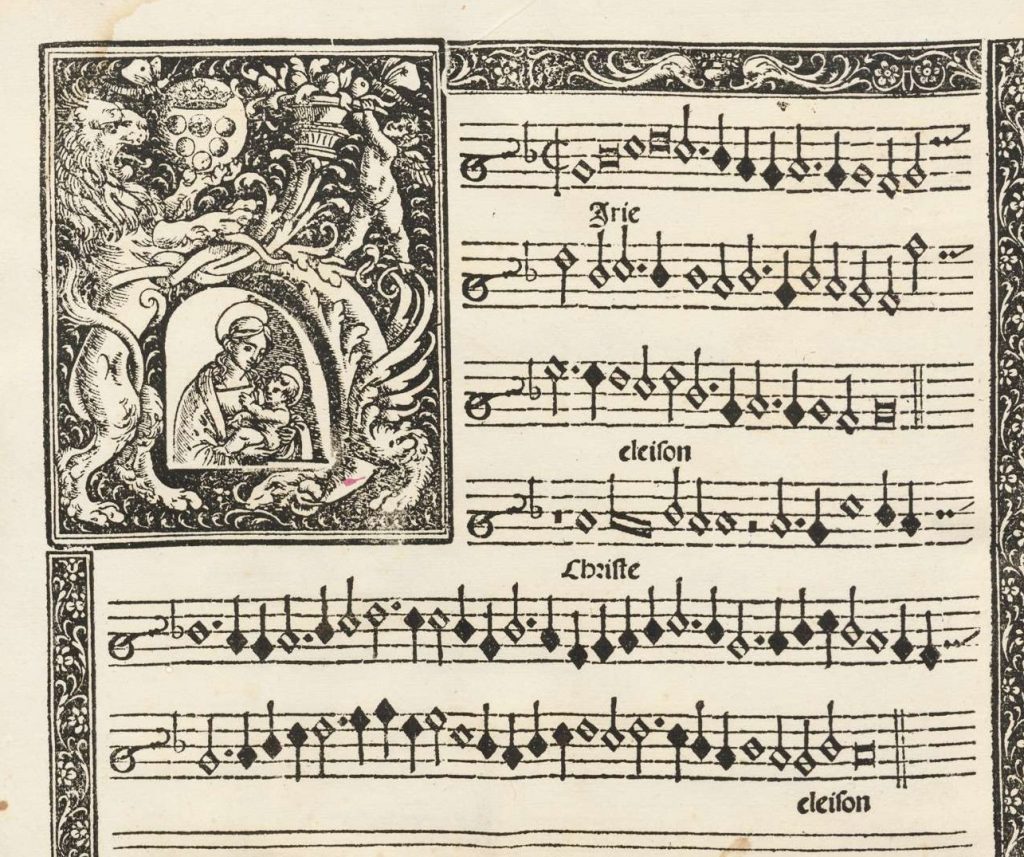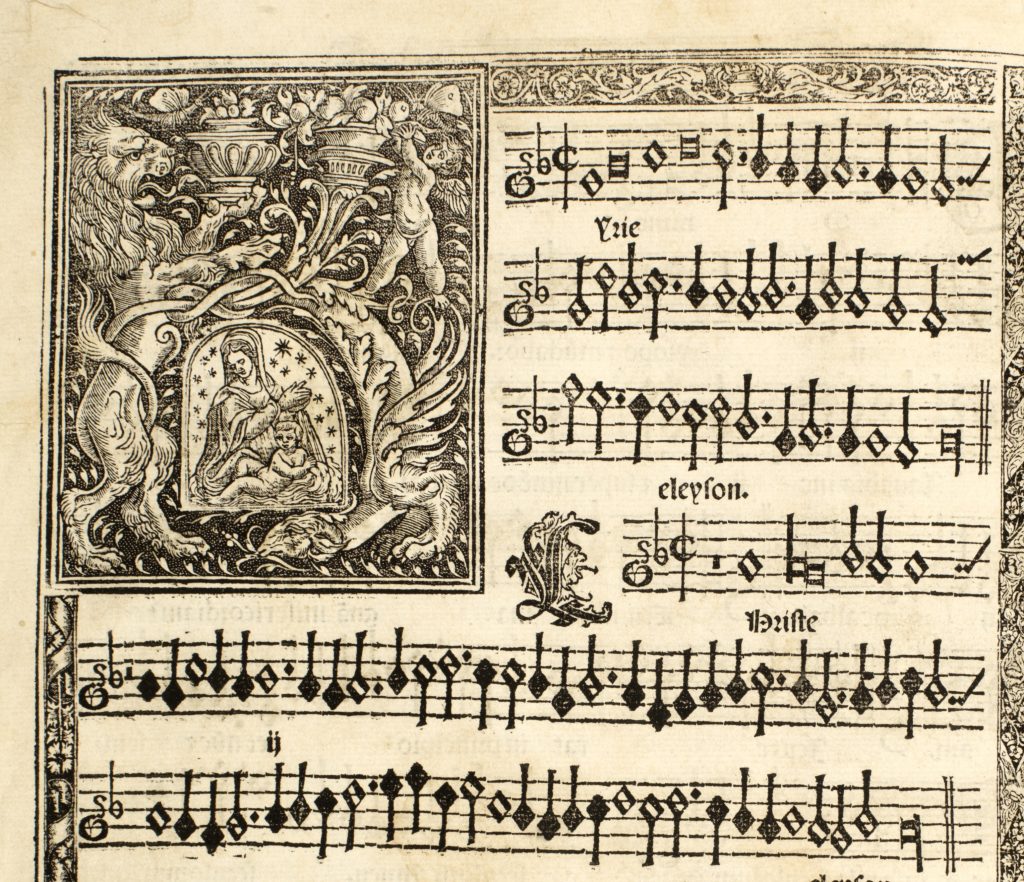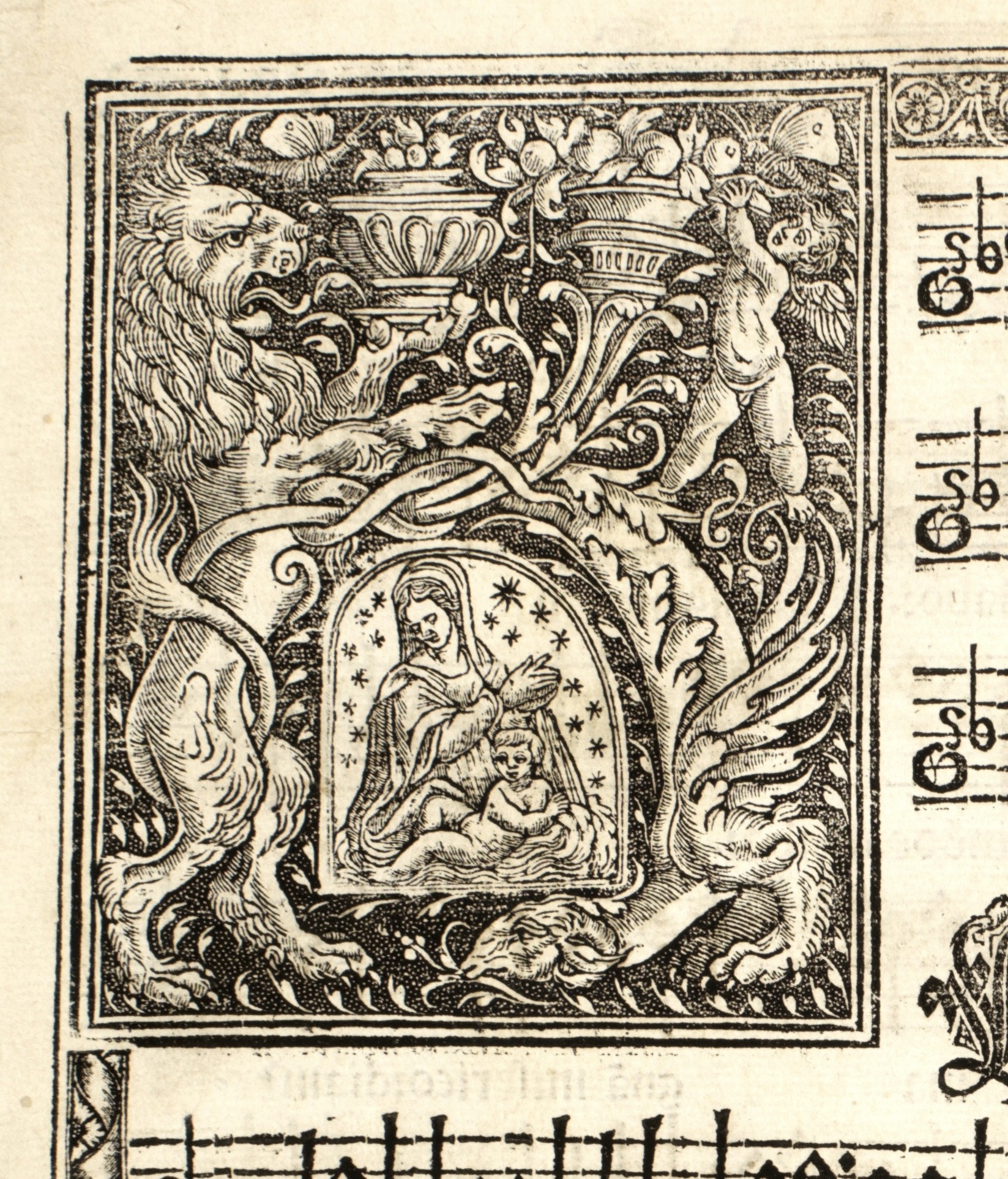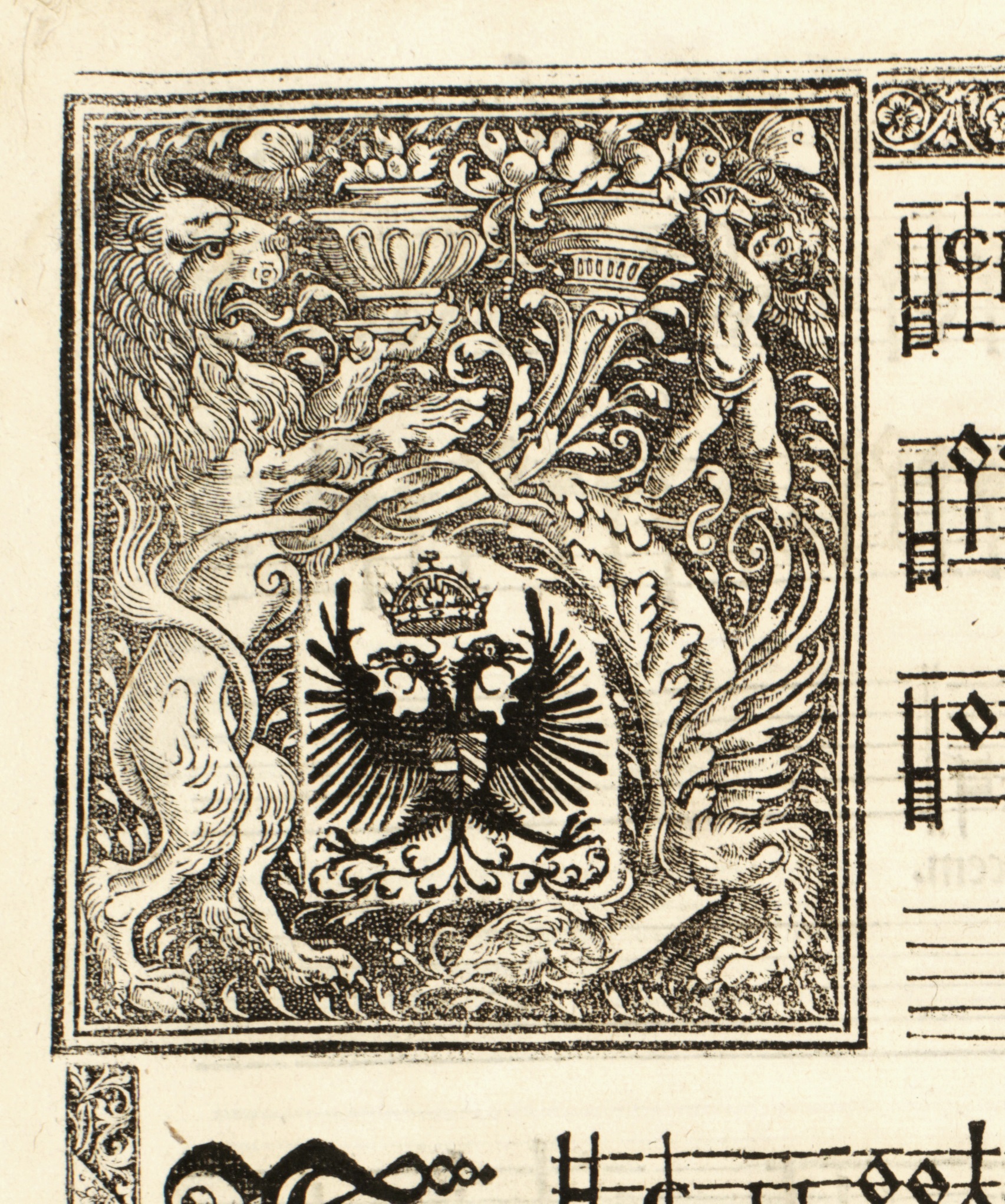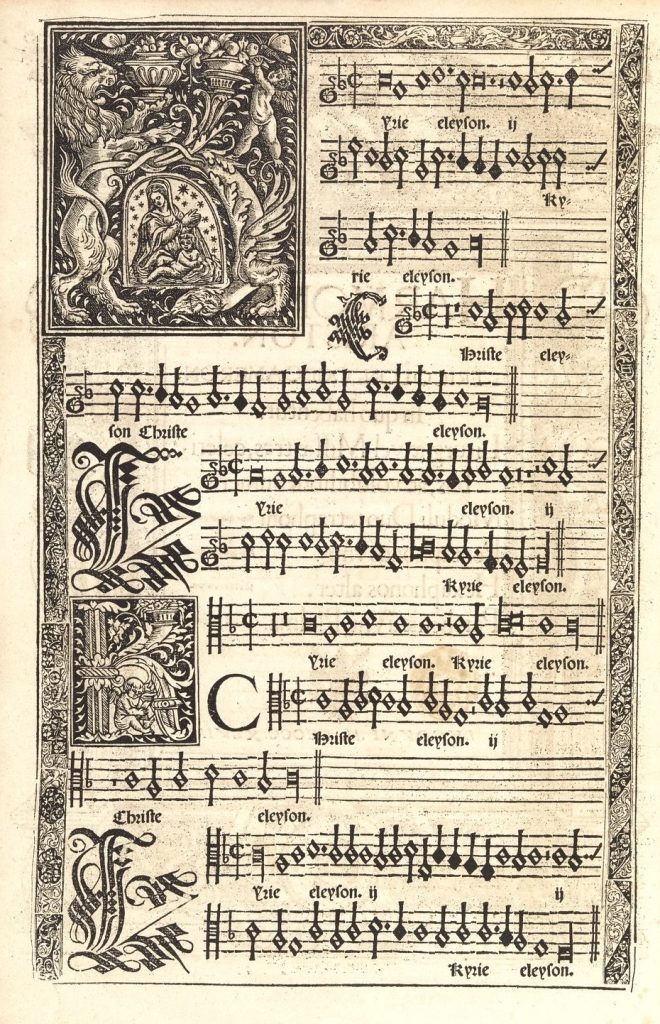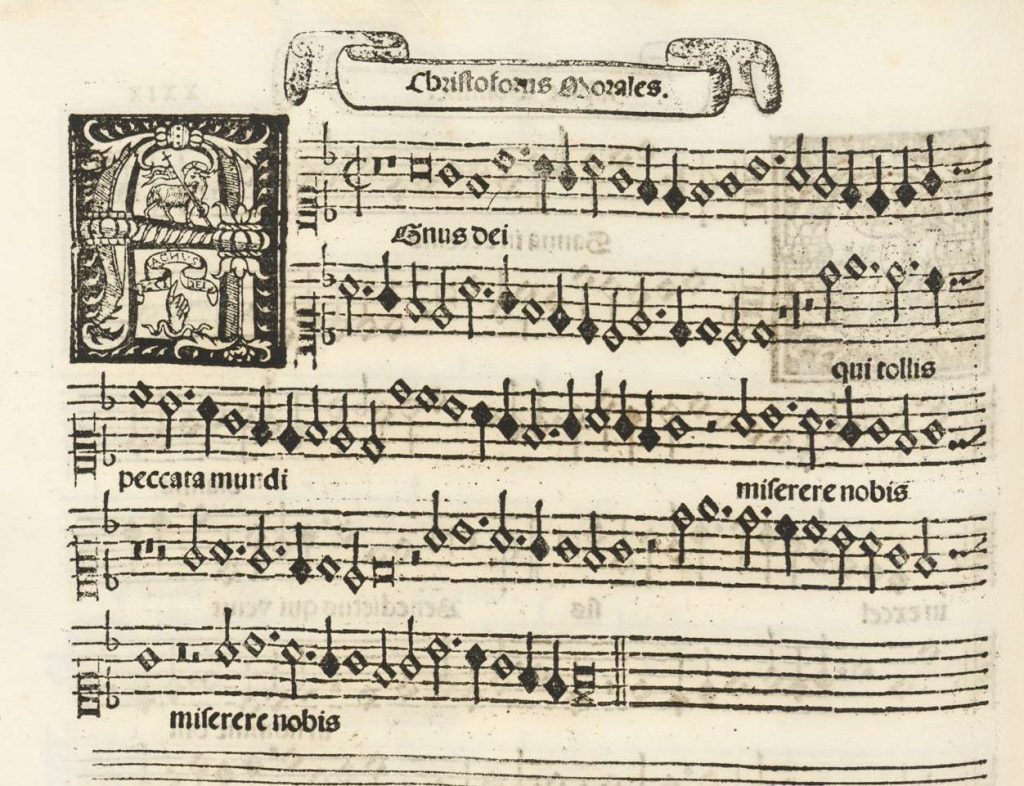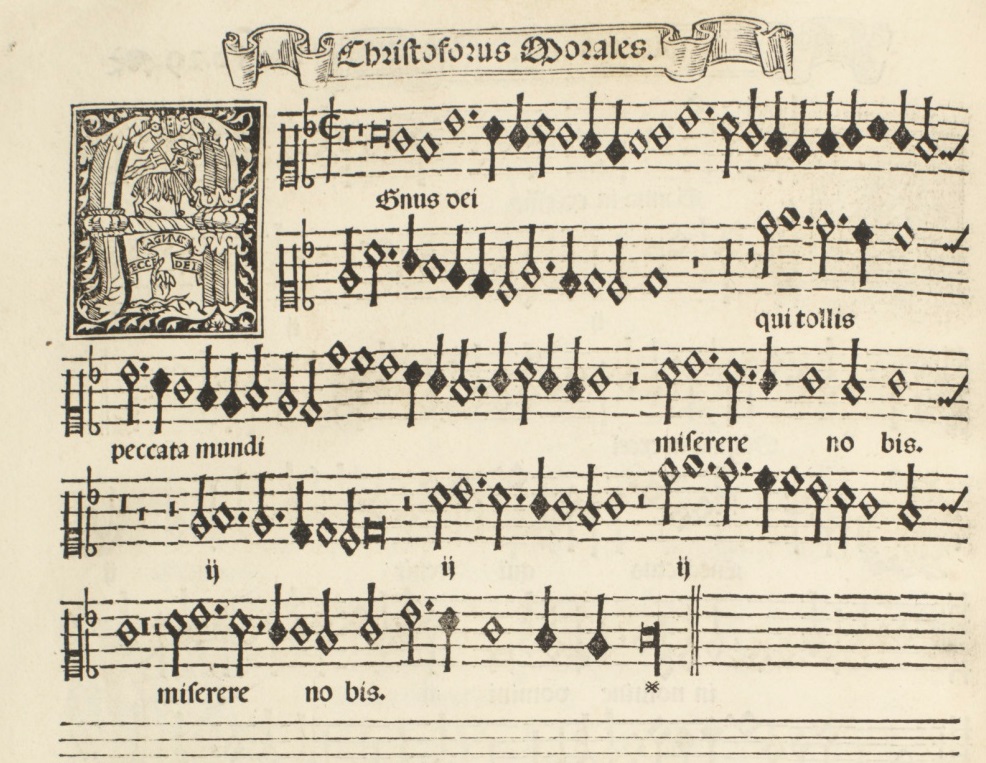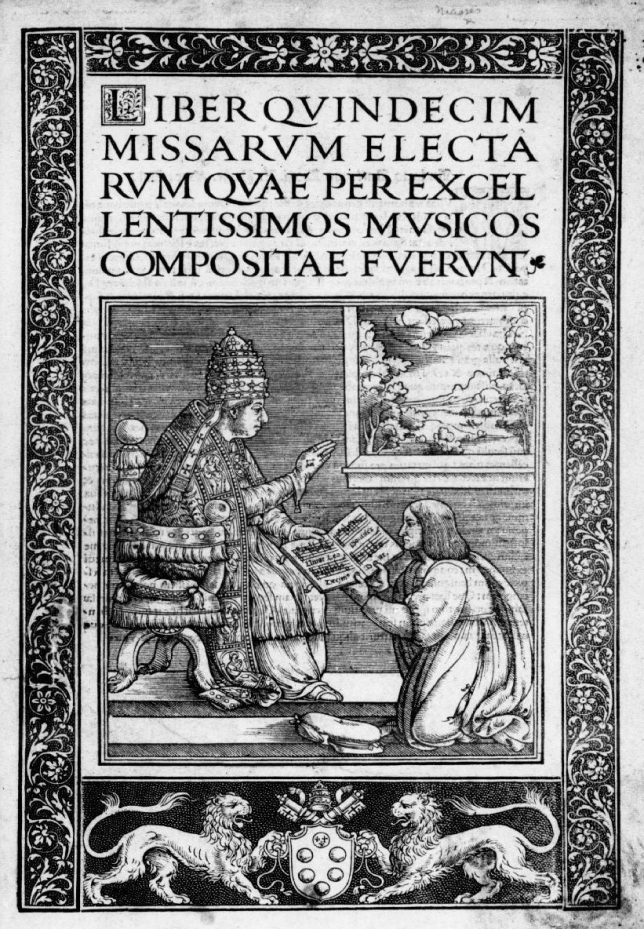
Buzet (Pinguente) in Croatia, a territory ruled by Venice in the 16th century. White squares mark Buzet, Venice, Lyon, and Rome
The printer of the John J. Burns Library’s edition of Morales’s first book of masses, Jacques Moderne, was born toward the end of the 1490s, in the Venetian territory of Istria (now in Croatia), probably of Italian parents. In 1523, his name was first registered in the civic records of the city of Lyon, in the south of France, where he spent the rest of his professional life, dying there probably some time in the 1560s.
On the title pages of some of the many Latin-language books Moderne issued from his Lyon press before 1540, he described himself as “Jacobus Modernus de Pinguento,” thus informing his readers that he came from the town of Pinguente (now Buzet, in modern Croatia).
After 1540, Moderne dropped any reference to his origins, and simply signed himself as “Jacques Moderne” or the more colorful “Jacques Moderne, dit Grand Jacques,” as in his 1541 anthology Le parangon des chanson where, in addition, he gives the location of his print shop: close by the church of Our Lady of Comfort (“pres nostre dame de Confort”).
The church in question, long since demolished, stood on the rue Mercière, a busy commercial thoroughfare that linked the city’s two main bridges, the area from which many of Lyon’s printers and publishers operated, as shown in contemporary maps.
Apart from what little can be gleaned from Moderne’s surviving publications, we know little of his life. Today he is remembered chiefly for his musical publications, though this musical bias simply reflects the fact that, to date, musicians and musicologists have shown more interest in his large printed output than have scholars working in other disciplines.
Moderne himself may not even have been particularly musical, or even much interested in music beyond its potential for earning him commercial rewards. Printing and publishing titles on such diverse subjects as theology (including several volumes of the works of Erasmus), canon law, fishing, animal husbandry, medicine, cookery, and guides for happily (and unhappily) married couples, and printing them in both Latin and French, Moderne was equally, or possibly even more, interested in the market for non-music items than the specialist music market. As can be seen in this woodblock image from the title page of a publication for the non-music market.
Another pirate publication by Moderne was the Livret nouveau auquel sont contenuz XXV receptez esprouvez de prendre poisons, cannes, & oyseaulx … (A new booklet containing 25 ways of catching fish, dogs, birds …). The original book from which his pirate edition was copied actually described 27 ways of making the catch. Moderne, however, having used up all the pages he had allowed for the task after printing 25, reprinted his edition of the book omitting the last two, and apparently altered the title to reflect the reduced number.
Even after his death, probably in the 1560s, the name of Moderne lived on in books issued perhaps by one of his sons. The manual of canon law whose title page is illustrated below was printed posthumously under his name as late as 1589. As for music, Moderne issued about 50 separate publications containing a total of about 800 different musical works. Not only did he publish dozens of books of sacred and secular vocal polyphony—masses, motets, and chansons—but he also printed collections of instrumental music, notably some of the earliest publications for the lute. The title page of one of these is shown below.
Among his editions of Gregorian chant is a deluxe psalter shown below; it contains chants for the psalms for use in the churches of the city of Lyon. For several centuries, manuscript books of plainsong (like the John J. Burns Library’s Franciscan antiphoner) had typically been copied using red ink for the musical staves, and black ink for the notes and the bulk of the text. From their first appearance at the end of the 1400s, printed plainsong books adopted the same color scheme.
As can be seen in Moderne’s psalter print above, he too used red ink for the musical staves, for initials and capital letters in the texts, and for some titles, while the musical notes and most of the verbal text were printed in black. To produce a print like this in two colors, the page had to pass through the press twice, once for each colored ink, and the printer had to take great care that the two impressions were properly aligned. It was a painstakingly slow process that added to the expense. Moderne and his workers, however, faced no such problem when printing vocal polyphony like the Morales book, which was typically printed in a single impression with black ink only.
Moderne was, in fact, the first printer to publish Morales’s music. In the period 1532 to 1547, Moderne issued no fewer than eight anthologies of motets by some of the most important composers of the age and in his Motteti del fiore of 1539, he chose to include two four-voice motets by the Spaniard: Jam non dicam vos servos and Sub tuum praesidium. Whether on account of its inherent musical qualities or its commercial viability, Morales music so impressed Moderne that, by 1551, he had published no fewer than three large folio books devoted to Morales’s masses and magnificats. The first of these books would be one of many pirate editions, a copy of which is the John J. Burns Library volume (RISM M3581).
Moderne pirates Dorico
The first edition of Morales’s first book of masses was published not in Lyon in 1546, but in Rome in 1544. The contract, a transcription of which was published by Suzanne Cusick, is one of the few music printing contracts from this period to have survived. Dated 10 February 1543, it records an agreement among the following parties: the composer himself, the financiers Antonio de Salamanca (woodcutter and editor) and Giovanni Della Gatta, and the printer, Valerio Dorico. Morales himself paid for the paper and printing costs of 250 of a total print run of 525 copies. He paid for all elements of the decorations and illustrations for the entire print run and he accepted responsibility for proof reading. The printing costs of the remaining 275 copies were borne by Antonio de Salamanca and Giovanni Della Gatta who, in return, would be given 250 copies to sell anywhere but in Spain. Of the 275 printed copies that would be given to Morales, the composer would only be allowed to sell 50 in Italy, though not through any retail outlet. He was free to sell the rest in his native Spain, and the profit he made from these sales would effectively be Morales’s royalty payment. We know, for instance, that on his arrival in Spain in 1545, Morales sold copies of both books of masses to Toledo cathedral, where he had just been appointed as chapelmaster. Although Morales himself bore the largest financial risk in this printing venture, he also retained a high degree of control.
We do not know how many years it was before all 525 copies of the original authorized Roman edition were sold. But almost certainly, Morales and the Italian publishers still had a large number in stock in 1546, the year in which the matters of supply and demand were to become more complicated. By some means, Jacques Moderne in Lyon had purchased, or otherwise acquired, one or more copies of the book, possibly in the first instance to retail them in his shop.
Realizing that the title created considerable interest among his own customers, he decided to print his own pirate edition, simply copying the music carefully, note for note, from Dorico’s original Roman print, and selling the counterfeit print-run for his own profit. Neither Morales nor his Roman publishers would receive any cash benefit at all from Moderne’s pirate edition.
Not only did Moderne copy Morales’s music, he also copied skilfully and closely almost every aspect of Dorico’s original book design and layout. In fact, the decorative scheme and the layout of Dorico’s volume was itself based on the decorative scheme of an earlier Roman publication, namely the Liber Quindecim Missarum (Rome: Andrea Antico, 1516). A comparison of the opening page of the first mass from the Moderne and Dorico editions, immediately reveals the similarities.
Moderne (right) closely imitated the decorative scheme of Dorico’s (left) floriated page border, even copying such details as the small grotesque face at the center of the bottom border. He similarly copied the characteristic details of the larger and smaller initial letters “K”.
In Dorico’s original, and Moderne’s copy, both these elements of the page design were printed from specially carved woodblocks. These woodblocks can be compared more closely in the paired illustrations below. In both Dorico’s and Moderne’s editions, the letter “K” was printed from two physical elements: the “K” itself was printed with one large woodblock, with a space in it between the two lower extenders, into which a second smaller woodblock was inserted with vignettes of the Virgin and child.
Such an arrangement allowed both Dorico and Moderne to reuse the “K” initial for the first movement of each mass while inserting within it a smaller woodblock whose decorative images would relate more appropriately to the theme of each individual mass.
- Figure 1
- Figure 2
The vignette of the Virgin and child (Figure 1) appears, fittingly, on the first page of the Morales’s Missa de Beata Virgine. The vignette depicting the bicephalous eagle emblem (Figure 2) used by the Holy Roman Emperor Charles V, appears on the first page of Morales’s mass based on the chanson Mille regretz. This chanson became so identified with Charles V that it was often referred to as “the Emperor’s song” (“La canción del emperador”).
Moderne later reused his counterfeit woodblocks, made especially for his pirate Morales edition, in at least one other book of masses. Pictured in Figure 3 is the first page of music from a book he published two years later, in 1548 (the opening of the Missa Veni sponsa Christi by Pierre Colin); note that the large initial “K”, with its vignette of the Virgin and child, is printed from the same woodblocks as the first page of our 1546 Morales edition.
- Figure 3
Moderne made his own counterfeits of several other woodblock designs from Dorico’s original Morales edition. Figure 4 shows Dorico’s “Agnus Dei” woodblock, used on the opening page of the original 1544 edition of Morales’s Missa Aspice Domine; Figure 5, which is clearly modeled upon it, shows Moderne’s “counterfeit” woodblock, from the corresponding page of his pirate edition.
None of the design and layout elements of the Dorico or the Moderne pirate editions of Morales’s masses can be properly understood without reference to Andrea Antico’s 1516 mass anthology, the Liber quindecim missarum. Benefiting from a privilege granted him by the Medici Pope Leo X, a privilege that granted him exclusive rights to the publication of large format music books, Andrea Antico dedicated an enormous effort to the production of a book that, with an unusually large print run of over 1,000, became the model for generations of mass books in choirbook format. Unlike Ottaviano Petrucci, the pioneering Italian publisher of polyphonic music, Antico employed both woodblocks and metal type in his editions. In the Latin dedication to his Liber quindecim missarum, Antico seems to take credit for introducing the technique of cutting musical notes into wooden blocks. But if he was not the first to use the technique, he was certainly the first to employ it on such a grand and impressive scale. Privileges granting the exclusive right to print music were awarded to both Petrucci and Antico by the music loving Pope Leo X, the eldest surviving son of Lorenzo “the Magnificent” de Medici, and Antico made his gratitude abundantly clear in both the frontispiece, the prose dedication, the various decorative elements, and even the selection of repertory in his mass anthology.
A close examination of the frontispiece of Antico’s Liber quindecim missarum reveals the publisher—not, as we might expect, the composer—humbly offering an open music book to the enthroned and pontifically vested Pope Leo X. The music notated in the open book is a simple canon setting the laudatory motto “Vivat Leo Decimus, Pontifex Maximus” and the lower border combines the Papal arms with the six “palle” (balls) of the House of Medici flanked by a pair of lions in reference to the Pope’s chosen name.
While Dorico was clearly inspired to imitate Antico’s frontispiece when he came to printing Morales’s second book of masses, he adopted an entirely different strategy for his frontispiece for Morales’s first book of masses, illustrated here.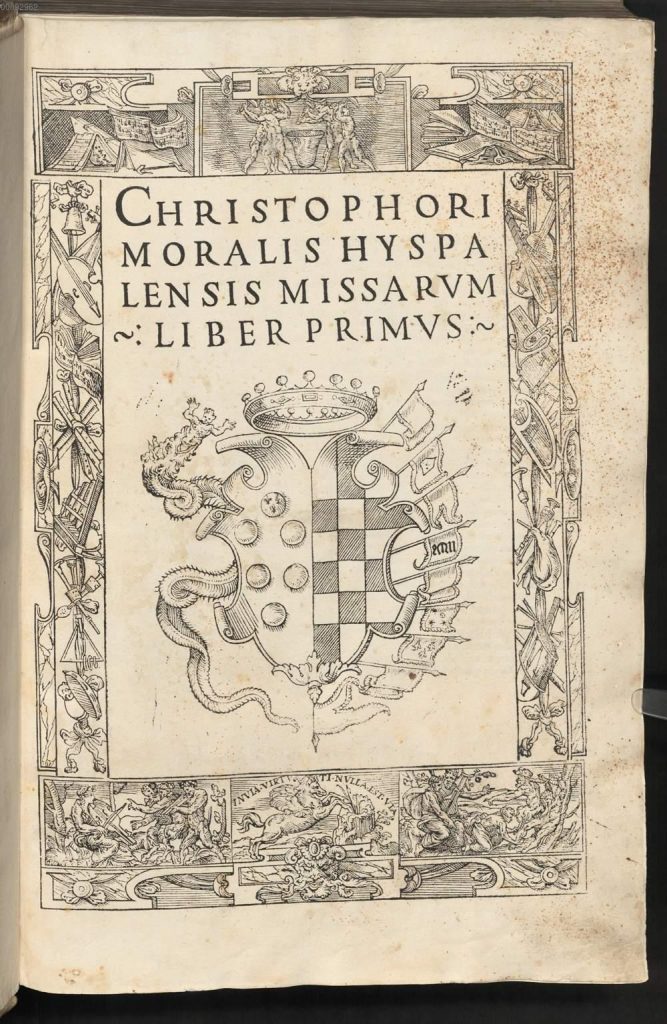 By today’s standards, Moderne’s pirated Morales edition would simply be considered illegal. We would argue that the Lyon printer was infringing the composer’s copyright, thereby denying him the benefit of royalties, and making it more difficult for his Roman publishers to recover the cost of the original edition.
By today’s standards, Moderne’s pirated Morales edition would simply be considered illegal. We would argue that the Lyon printer was infringing the composer’s copyright, thereby denying him the benefit of royalties, and making it more difficult for his Roman publishers to recover the cost of the original edition.
Yet it would be misleading to suggest that Morales did not ultimately benefit from Moderne’s piracy. In effect, Moderne’s edition effectively doubled the public exposure of both Morales and his masses. Perhaps as many as a thousand copies (rather than the original 525) were now in circulation, thereby enhancing Morales’s reputation, and ensuring that his music was known and sung more widely than would otherwise have been possible. And today, it is still slightly easier to come by a copy of Moderne’s pirated edition than it is an exemplar of Dorico’s original. In fact, Moderne’s Lyonnaise “counterfeit” was occasionally mistaken, even in Rome itself, for the first edition. This can be seen in the page shown below, from Nicolo Antonio’s bibliography of books by Spanish authors, printed in Rome in 1572. 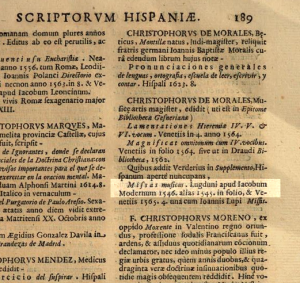 In a far-from-complete list of Morales’s published works, it registers copies of Moderne’s Lyon print with both “1545” and “1546” on the title page, but fails to note the existence of Dorico’s 1544 original edition.
In a far-from-complete list of Morales’s published works, it registers copies of Moderne’s Lyon print with both “1545” and “1546” on the title page, but fails to note the existence of Dorico’s 1544 original edition.
